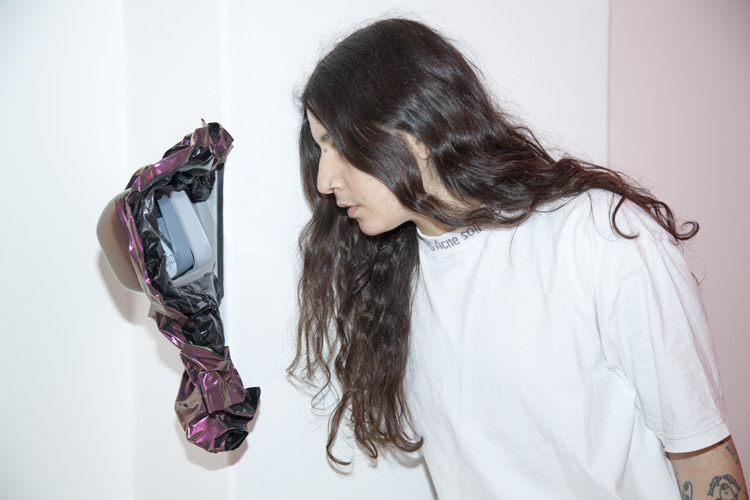
An Interview with Maltese-born, London-based Artist ROXMAN GATT
“The work I make is vulnerable and intimate, draws from the personal, yet it is universal and relevant to anyone who has loved, been loved and is just trying to figure out why love hurts.”
ROXMAN GATT

Pain[ting]
2018
Spray-paint on canvas, plaster bandage, casted concrete
101.6 x 101.6 x 3.8 cm
Courtesy of the artist and Harlesden High Street Art Gallery, London
Eve Cocks: ‘Contemporary love’ is a powerful and recurring theme, and one that was central to your first solo exhibition, Perfiction. What do you mean by ‘Contemporary Love’.
Roxman Gatt: In my mind contemporary love is still similar to the love between Romeo and Juliet. The passions and the agonies are still very much present, and loss and loneliness persist. However, it feels like it is much faster love, running at similar speeds to that of a fast internet connection. Technology continues to greatly impact our way of living. The way we behave/relate with other human beings has become similar to the way we multitask, browse the internet and use certain internet apps.
EC: You’ve been using text ever since your early works.
RG: It is often through writing that my work starts to take life. My mission is to make these texts tangible and visible, in the best possible way. These ideas/words exploit various media depending on what seems fit for the emotions being evoked. Fragmented bits of writing become names for artworks and are as important as the artwork itself. Sometimes these texts turn into ‘pop’ tunes and other times they just inspire an artwork, be it a painting, photograph or a sculpture.
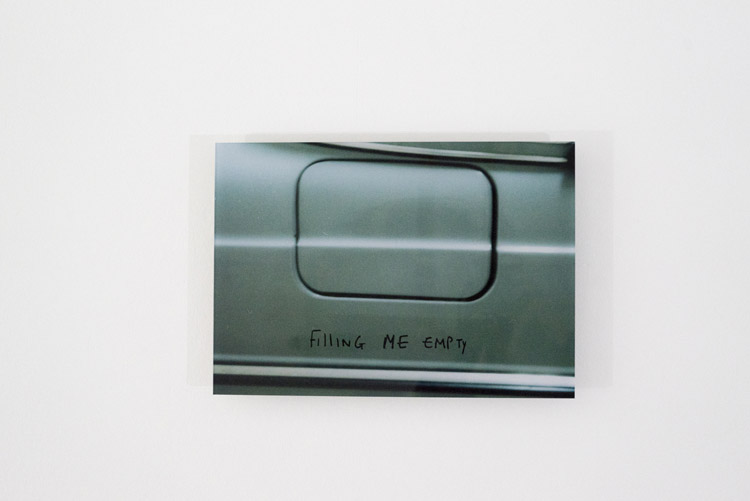
Filling Me Empty
2018
Digital C-Type print mounted on reverse perspex
420 x 297 mm
Courtesy of the artist and Harlesden High Street Art Gallery, London
EC: Your work is deeply personal.
RG: Whether one’s work is about their life or not, to fully avoid referencing it is quite difficult and maybe impossible. It is quite likely that many artists would draw from their own personal experiences in relation to the world or spaces they inhabit. This doesn’t have to be shown explicitly or made to be the essence of the work. I know for certain that the work I make is vulnerable and intimate, draws from the personal, yet it is universal and relevant to anyone who has loved, been loved and is just trying to figure out why love hurts.
EC: The ‘car’ plays an integral role in your work – in particular, the crashing of the car.
RG: My work delves into a variety of concerns such as identity, gender inequality, emotional pain… I use the car – its manipulations, actions, and distortions – to bring out these concerns. Crashed, blown and crushed up cars symbolise a broken heart. I associate the crashing of the car with a painful end of a relationship or a friendship. I also use the car to explore the notion of ‘desire and fetishisation of the inanimate object’. Consumption and consumerism have become a way of life; the way we desire objects seems to me quite similar to the way we desire a human being.
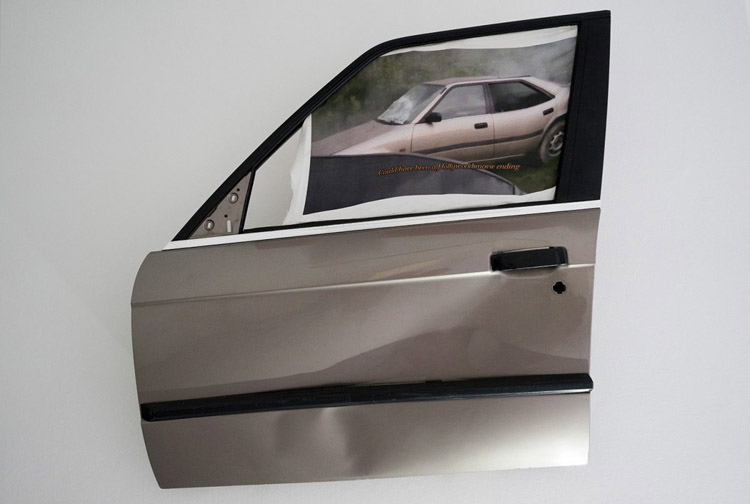
Could have been a Hollywood Movie Ending part [2]
2018
BMW E30 door, fabric printing
92 x 102x 14 cm
Courtesy of the artist and Harlesden High Street Art Gallery, London
EC: You always seem to work with a specific car, the ‘BMW E30′.
RG: The BMW E30 is a cult car. I feel really connected to it and I like it aesthetically as an object. About three years ago, I appropriated the logo ‘BMW’ and I imbued it with another meaning – ‘Be My Womxn’. Since then I just stuck to it. I feel I cannot work with another car.
EC: Your performances are physical and sensual. How does the audience react to them?
RG: I am not usually aware of reactions as I tend to ‘get lost’ whilst performing. During the Perfiction performance, which mainly looked into being punched and falling, I combined manly-dude gestures and sensual moves. I played between male and female roles and consequently with sexual identity.
EC: You’ve recently worked on a new performance My Womxn is a God My God is a Womxn.
RG: This performance was held in collaboration with four other artists. Some of the main inspirations were derogatory words used for womxn, witches and Joan of Arc. The intention of the work was to reclaim these derogatory terms by celebrating their meaning through the means of movement and sound. Six songs were written in total. Choreography was devised to go alongside these songs as well as painting, video and sculptural works. Various clubbing gestures such as ‘windmill’, ‘headbanging’, ‘cruising’, ‘moshing,’ as well as the witch dance from Metropolis (1927) and the interpretation of ‘Slut’ were all referenced for the creation of the piece.
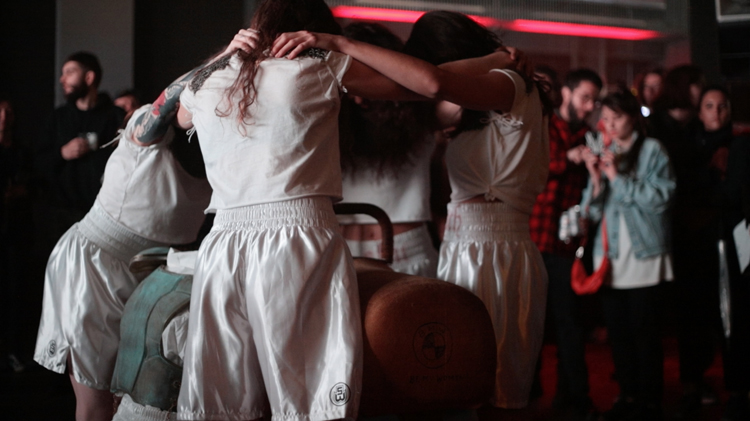
My Womxn is a God my God is a Womxn | Up is a Relative Concept @ Fold_Lab (09/05/19).
Performance & Sound – Roxman Gatt; Choreography – Roxman Gatt, Sim Gray; Moving Image – Roxman Gatt, Sim Gray; Filming – Sunn; Dancers – Roxman Gatt, Sim Gray, Chyrsso Cosmas, Eleni Papazoglou, Rosalind Wilson.
EC: Are all of your performances choreographed?
RG: Yes they are. Often choreography is employed after I would have completed a sound piece. I would then start to work with texts/poems, themes and other content that I would have been researching throughout the project. This usually allows me to get in the studio and start experimenting with movement. In the studio I like to draw elements from the everyday – certain habits, actions and ‘quoted behaviours’ (actions and images that appear out of context). There is a structure and there are rules in all the performances I choreograph, however, there is always ample of room for improvisation, and this acts as an important element to the delivery of the performance.
EC: When I visited Perfiction at Harlesden High Street art gallery in London earlier this year, I was intrigued to experience so many different works in one space.
RG: Emotions have multiple facets and are expressed in multiple ways. So I don’t see how I could ever express different kind of emotions such as anger, sadness, and joy through just one medium. I’ve always been like that. I can’t imagine myself working solely on painting. This would limit me.
EC: Is it correct to say that Perfiction summed up your practices as an artist?
RG: I’ve always exhibited in group shows, so Perfiction really summed up what I have been doing. I’ve been exploring the same concepts and practices for years and with it I feel I’ve managed to tie in all my disciplines and media together – sound, performance, text, painting, film, sculpture, video and photography. Movement and sound are very crucial to my work as it brings the work closer to the audience. This is why I also focus on performing in public and not just behind the screen; the audience can get more of an understanding of who I am. Perfiction represented where I stand as an artist now.
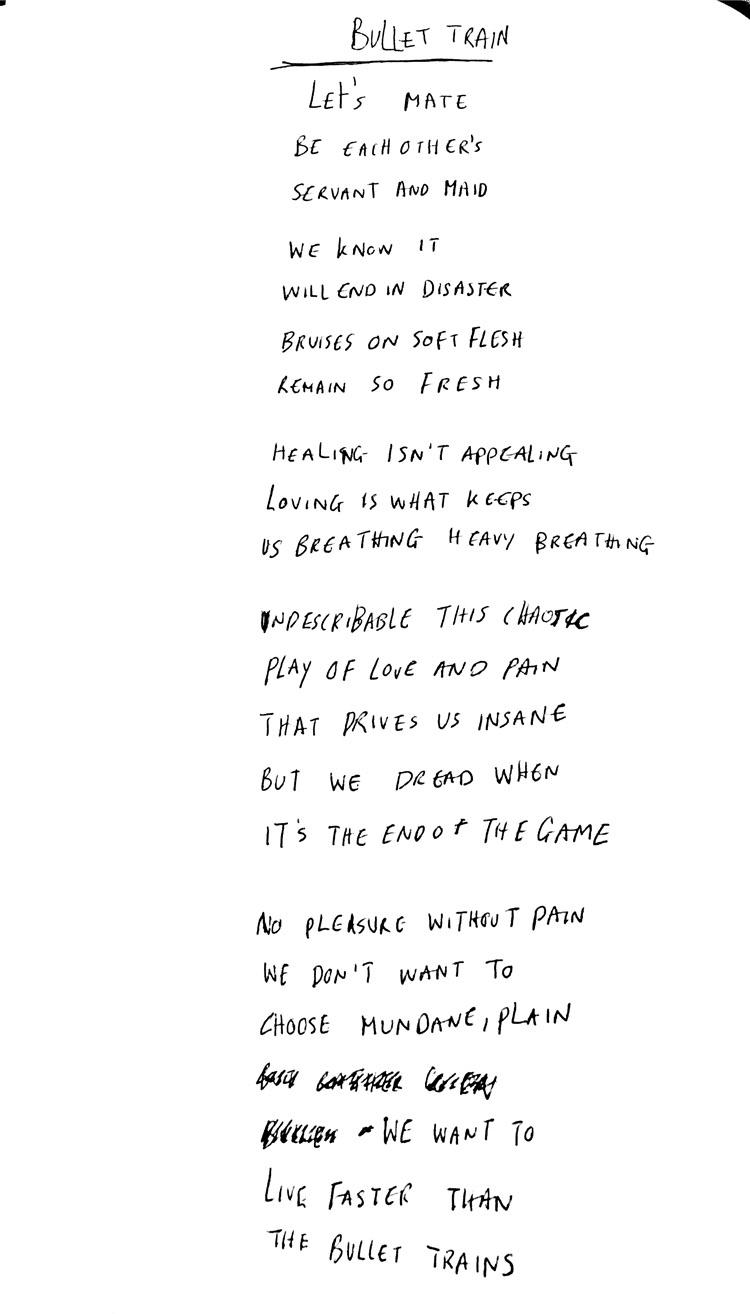
Bullet Train
2019
Poem (turned into a song as part of My Womxn is a God my God is a Womxn perfomance
Courtesy of the artist
ROXMANN GATT has exhibited extensively in the UK and further afield. Find out more about the artist here roxmangatt.com
